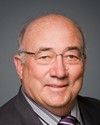Thank you very much, Mr. Chairman.
With me today is the Executive Director of the Société des musées québécois, Mr. Michel Perron, who will also be able to answer your questions.
My presentation will be quite brief and to the point. Since I'm speaking last, I think I am repeating what has already been said.
Like the other provincial associations, the Société des musées québécois is in full agreement with the position taken by the Canadian Museums Association. This network of national and provincial associations has been working cooperatively and effectively for some 40 years now. In fact, a number of our associations are offspring of the national association, and this allows each of us to have our own interests.
The actions of the Société des musées québécois and of the Canadian Museums Association, as well as those of all the other provincial associations are designed to promote their best interests. However, our chief concern is the best interests of museums generally.
The Société des musées québécois has been in place since 1958 and represents over 300 institutions, museums, exhibition and interpretation centres, as well as the individuals and professionals who work in museums or in connection with museums.
We have over 2,000 institutions throughout Canada and they receive quite a number of visitors. In Quebec, the 420 museums have a total number of visitors of some 12 million. I would point out that although some of these institutions are not members of the Société des musées québécois, they do the same work and share our objectives.
I've been working in this field for 36 years, for the same museum, and I have seen the network develop. Museums are a symbol of stability, a reliable place that people can come back to at difficult times. Despite the dedication, work and competence of the managers and volunteers who work in this field and despite the magic we try to produce, the current situation facing the museums is precarious and is affecting everybody.
We are aware that we have a public mission and mandate to achieve in the context of a society that is constantly evolving. One of the challenges we will have to meet in the next few years will be to meet the requirements of an increasingly demanding and informed public—one that grew up with us. They are therefore accountable to our public.
This new reality is expressed in different ways. First of all, there are the baby-boomers, who have taken early retirement or who have simply retired. These people are well educated and want high-quality products. And then there is the role museums are required to play in integrating newcomers into our multicultural society. This role will become increasingly important.
Of course, museums must play to their strengths. One of their strengths which should not be forgotten is their hallmark: the collections they house and the conservation of these collections.
I totally agree with my colleague that the buildings and spaces that house museums are also part of our collection and deserve to be protected and preserved.
In order to carry out our mandate, over the years we have developed a talent for unifying people. We work with universities, schools and communities, bearing in mind that we have a research and conservation vocation and that we must offer high-quality products. People no longer buy just anything.
We try to balance our various responsibilities, and in order to do that, we have to make some compromises. We have become experts at compromise, because we have to make compromises every day. We have also developed a talent for getting financial and human resources and in using them efficiently.
We have achieved many things. We have used the expression "With a little help from my friend" in our paper. Museums need their friends, including the municipal, community, provincial and federal levels of government. We cannot disregard of these levels, nor of the private sector. We have become masters at seeking assistance from the private sector and from volunteers.
Museums face a problem of perception. I am speaking to you as a practitioner and on behalf of the Société des musées québécois. We provide people with an essential service, and a number of our institutions are private, not-for-profit organizations. This role is dear to us, and the public supports us by visiting museums.
I can only say that I strongly support what my colleagues John McAvity and Gerry Osmond, from Alberta, or the other representatives of provincial associations have told you about the role the federal government should play with respect to museum culture. It must play a stewardship role with respect to the national museums so as to conserve and protect Canadian heritage and to promote the conservation, interpretation and dissemination of this rich heritage.
In the last two years, the Canadian Museums Association invited us to take part in developing guidelines for a new federal museum policy. We contributed as an association. We arrived at a general consensus that is understood by everyone, and this gave us a certain momentum.
Multi-year funding is one of the cornerstones of the new museum policy. The principle is that to manage our institutions properly, we need multi-year funding in order to do long-term planning. Nothing happens instantly, nothing is decided overnight. When a program is slow in getting back to us, we have difficulty managing our institutions properly.
So we support John and the Canadian Museums Association. There is an urgent need for a museum policy complete with funding.
The cutbacks announced on September 25th of this year are unfortunate and absolutely unjustifiable, particularly the arguments put forward to explain them.
During the 2004-2005 fiscal year, 58 projects were subsidized by the Museums Assistance Program. The 58 projects never received the funding requested. Each project received some money, but not necessarily the amount requested—that is part of the rules.
If we apply the 25% cutback over two years, the $2.3 million that Quebec received for the 2004-2005 fiscal year will be reduced to $1.7 million. That would mean a reduction in the number of projects from 58 to 33. It's quite a simple mathematical calculation. However, I have been on peer review boards for these programs and applications, and I can tell you that that is not how things work. The peers themselves give preference to certain projects over others and make recommendations to the minister.
These budget cutbacks will create instability for the institutions that take the trouble to prepare these projects, which are designed, we should remember, for Canada-wide dissemination. Travelling exhibits go around the country and promote dialogue with others. Setting up an exhibit of this type is a long process and that requires a great deal of planning. And now all our efforts count for very little.
I see that I have gone over the time I was given, but it is important to make these arguments. These cutbacks will result in the disappearance of these projects and will reduce job opportunities for graduates of museology. These students find jobs and get contracts as a result of these projects.
People who justify these cuts by saying that museum management is ineffective are extremely unfamiliar with the situation. The response and reaction of the museum community are clear evidence of the real situation.
I will not go over in detail the two requests and resolutions passed unanimously at the annual general meeting of the Société des musées québécois. I would just say that in order to restore confidence, we need first and foremost a federal museum policy complete with funding, as well as a stay on the government's decision to cut back the Museums Assistance Program by $4.2 million.










